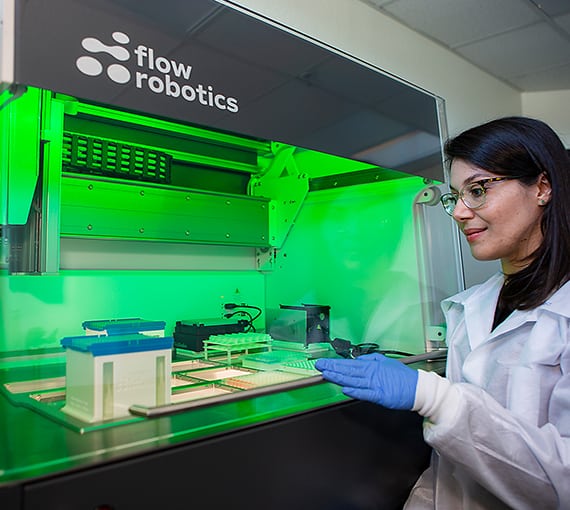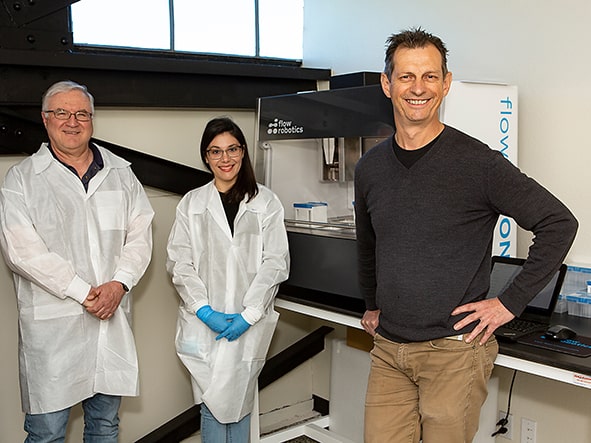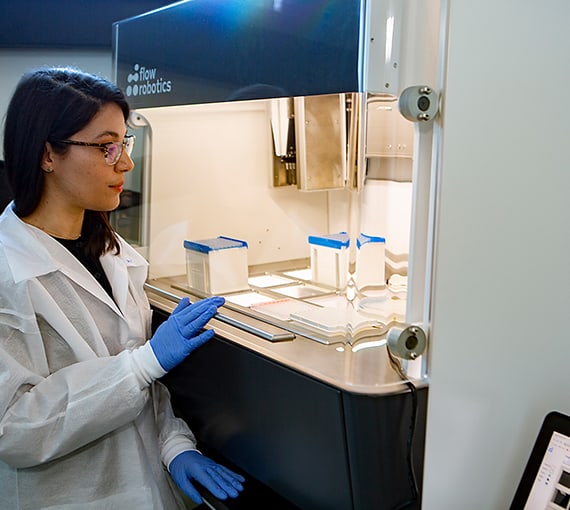Ensigna Biosystems
Makes lab work a breeze with flowbot® ONE
The California-based contract research organization, Ensigna Biosystems, uses the flowbot® ONE in research projects for biotech and biopharma companies. More specifically, to prepare samples for qPCR and, on occasions, protein assays.
This is a double win that enables them to accommodate their customers while creating a good working environment at the same time.
Optimizing workflow to meet customer demand
Preparing samples for qPCR in 96 well plates requires a lot of pipetting. In fact, it can amount to 200 pipetting moves per plate. This is time-consuming and tedious work to perform manually, which Ensigna Biosystems was doing prior to getting the flowbot® ONE.
The company decided to automate liquid handling because it was necessary to speed up their processes. Their clients were bringing in a large number of samples and pushing for faster results.
“Our different studies can have over a hundred samples, and for each sample we measure the level of more than one gene. That’s a lot of wells to fill. Our clients were really pushing us to get the results faster, so we started thinking about ways to optimize. This is where flowbot® ONE came into play. Now, our clients are really happy that we are able to do it faster,” explains Michel Faure, Ph.D., President, and CEO of Ensigna Biosystems, Inc.

Robert Ertsey, Sr. Manager of Lab Operations and the primary user of flowbot® ONE, experienced significant change in his everyday work after implementing the robot, making it a breeze to meet customer demand.
“flowbot® ONE allows you additional time for other procedures. We can do better experiments and use the time we save on analyzing previous experiments.”
He specifies that the same thing goes for avoiding human errors. An error might mean that they have to start the experiment all over. That is a huge set-back timewise.
Book a demo
– customized for your lab needs

To load a 96 well plate manually took me about 45 minutes. With the flowbot I do it in about 10 minutes. Previously we did around 3 plates per day, but we have been able to scale up to 6 plates per day by automating, and thus doubled our throughput. We could do many more if we did not have to wait for the PCR machine to finish.
Keeping focus on people and staff safety
For the staff, automating the workflow with the flowbot® ONE means less fatigue and stress which ultimately leads to better quality of life.
“If you have to aliquot out several 96 well plates per day, you expose yourself to hand fatigue as well as mental fatigue. When you are setting up experiments it is hard on your hands, and you are stressed about making sure everything is working well and keeping the error rate low. I used to experience daily fatigue and stress, but the flowbot® ONE has removed both symptoms. Once the software is set up, you can just press ‘execute’ and the flowbot will do everything else,” explains a relieved Robert Ertsey.
Michel Faure agrees; “setting up PCR plates is mentally challenging. If you are distributing liquid from one well into three receiving wells, it can be hard to keep track, and it takes a lot of concentration. You also have to decompress after each plate and do something else to stay sharp. Mentally it is a huge relief to automate that process.”
And, thus, Ensigna Biosystems is a great example of the major impact it can have for everybody involved when humans and robots work in parallel to achieve new heights.

Want to see how we can help your lab?
Just fill in the form and we can set up a free demo
– no strings attached
About Ensigna Biosystems
Ensigna Biosystems is a contract research organization that provides cutting-edge services to the pharmaceutical and biotechnology industries.
Founded in 2014, the company occupies 7300 sq ft of lab and office space at Gate510 in San Leandro, California and is fully equipped for histopathology, molecular biology, and tissue culture.

